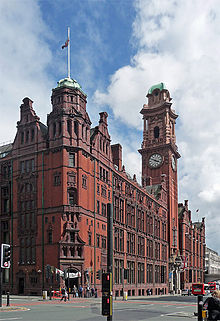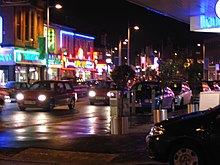
Wilmslow Road is a major road in Manchester, England, running from Parrs Wood northwards to Rusholme. There it becomes Oxford Road and the name changes again to Oxford Street when it crosses the River Medlock and reaches the city centre.
The road runs through the centres of Didsbury, Withington and Fallowfield, including the major student residential campus of Owens Park, to Rusholme. Oxford Road passes through the University of Manchester campus, the Institute for Contemporary Theatre campus of BIMM University and the All Saints campus of the Manchester Metropolitan University. Several hospitals including the Christie Hospital and Manchester Royal Infirmary have been built along the road. It also features several parks and gardens such as Fletcher Moss Gardens, Platt Fields and Whitworth Park.
The road is part of a major bus corridor with bus movements of over one a minute at peak times and is a key centre for business, culture and higher education.[1]

Wilmslow Road, Oxford Road and Oxford Street are part of an 18th-century route from Manchester to Oxford, and from there to Southampton, which can be traced on modern maps by locating roads which are called (or used to be called) the A34. Wilmslow Road was designated the A34 until 1967.[3] Many sections of the route have been re-designated when motorways and bypasses took the A34 away from its original route and they took names such as the A3400 and A44. The ancient route goes via Cheadle, Cheadle Hulme, Wilmslow, Congleton, Newcastle-under-Lyme, Stafford, Birmingham, Stratford-upon-Avon and Woodstock.
Oxford Road and Oxford Street are the continuation of Wilmslow Road into the centre of Manchester. Oxford Street begins at St Peter's Square 53°28′40″N 2°14′39″W / 53.4778°N 2.2441°W and the name changes from Oxford Street to Oxford Road as the road crosses the River Medlock 53°28′25″N 2°14′24″W / 53.4737°N 2.2401°W, placing Oxford Road railway station closer to Oxford Street than Oxford Road. Wilmslow Road starts at the junction with Hathersage Road 53°27′33″N 2°13′39″W / 53.4591°N 2.2274°W and continues to Parrs Wood 53°24′21″N 2°13′06″W / 53.4058°N 2.2184°W where it crosses the ancient county boundary into Cheshire. It crosses the River Mersey over the Cheadle Bridge into Cheadle. Its route is then called Manchester Road for a short time but there is a Wilmslow Road on the other side of Cheadle.
Oxford Street and a section of Oxford Road together form part of the A34. The B5117 consists of part of Oxford Road and part of Wilmslow Road. Though a continuous thoroughfare, part of Wilmslow Road also contains part of the A6010, the whole of the B5093, part of the A5145 and the whole of the B5095.
|
See also: Turnpike trusts in Greater Manchester |
In 1753, the Manchester and Wilmslow Turnpike Trust was created by Act of Parliament, with powers to build, maintain, and improve the most northerly stretch of the Manchester to Oxford route, funded by the collection of tolls.[4] In 1755 the trust built the first stone bridge over the Mersey. This collapsed in 1756 and was rebuilt in 1758. The bridge was replaced in 1780 and again in 1861.
The improved transport links spurred the development of villages such as Rusholme and Withington along the route. These villages eventually merged and became part of the city of Manchester. Chorlton-on-Medlock, the district nearest the town centre, was developed as a residential suburb in 1793–94 by the three landowners. Most of the important streets were given impressive names, Oxford Street, Cambridge Street and Grosvenor Street being three of these. Over the next fifty years residential development spread southwards as far as High Street (the old name of Hathersage Road). The very few remaining dwellings of that period include Waterloo Place, 323, 325, 327 and 333 Oxford Road and Grove House (316–324).[5]

In 1861 the turnpike trust was threatened with abolition but survived by offering to build Palatine Road from Withington to West Didsbury. All turnpike trusts in the United Kingdom were abolished by 1881. Until some time in the 1880s all of Oxford Road and Oxford Street was called Oxford Street (as far south as High Street). The present street and road with different series of house numbers were introduced so that Oxford Street ended at the old township border of the River Medlock. The Chorlton-on-Medlock section became Oxford Road and from Rusholme to Parrs Wood remained Wilmslow Road.
Horse-drawn omnibuses operated along Wilmslow Road from before 1850.[6] In 1877 the Rusholme Board of Health gained Parliamentary approval to lay tramlines. The trams were horse drawn and operated by the Manchester Carriage Company. Rusholme was incorporated into the City of Manchester in 1885. The city electrified the route in December 1902 and operated the new trams. The Tram Sheds, a feature of Wilmslow Road at the time were no longer needed and became a riding school and later the Rusholme Theatre.[6]
Kingsway was constructed in stages, from 1928, and completed in 1930.[3] It was built as relief road to ease congestion on Wilmslow Road to the west. It was named after King George V and was originally numbered A5079. It was one of the earliest purpose-built roads especially for motor vehicles, and built as a dual carriageway.[3] In 1959, it was extended south across the River Mersey to bypass Cheadle and later renumbered to become the A34 in 1967.
|
Main article: Wilmslow Road bus corridor |
Wilmslow Road is reputed to be the busiest bus corridor in Europe.[7] Several bus companies operate services along all or part of the corridor, competing for the large numbers of passengers who use the route. The main operators are Stagecoach Manchester (along with its low cost brand Magic Bus) and First Greater Manchester. Other buses along sections of route are provided by companies including Arriva North West and Bullocks Coaches. The number of competing companies has reduced in recent years, as since bus deregulation in 1986 it had been common for four or five different operators to run services along the length of the route at any one time.
The bus corridor is popular with passengers for its frequent bus services, relatively low fares, and services that run at any hour of the day. Other factors responsible for the high patronage include the high density of students and the notable public facilities that can be found along the route. Wilmslow Road is designated a Quality Bus Corridor by Transport for Greater Manchester.[8]
The Oxford Road Corridor innovation district is a square mile in the south of Manchester's city centre where two of the UK's largest universities, the University of Manchester and Manchester Metropolitan University, are based alongside Manchester University NHS Foundation Trust. These organisations oversee the area in a partnership incorporated in 2007 alongside Manchester City Council and Bruntwood.[9]
In 2015, The Department for Business, Energy and Industrial Strategy (BEIS) invited consortia, formed around geographic and technological themes, to apply to be involved in the science and innovation audit (SIA) process.[10] The Greater Manchester and East Cheshire SIA highlighted that 50% of the City Region's science and innovation assets were located in the Oxford Road Corridor. Recognising the region's ‘Core Strengths’ in Health Innovation and Advanced Materials, and ‘Fast Growth Opportunities’ focused on the future potential of Digital, Energy, and Industrial Biotechnology.
In 2018, Manchester City Council adopted a Strategic Spatial Framework for the Oxford Road Corridor to guide future development and protect the area's unique innovation eco-system.[11]
The Oxford Road Corridor is home to a wide concentration of public, private, academic, and clinical institutions, generating 20% of Manchester's GVA and providing 79,000 jobs. It is home to 50% of Manchester's life sciences businesses, 74,000 students including 16,220 international students, with 42% of all students studying STEM related disciplines.[12] Property companies Bruntwood and Bruntwood SciTech have invested significantly into assets in the area, acquiring the Manchester Technology Centre in 2003 and developing Manchester Science Park, and Citylabs both of which have designated Life Sciences Enterprise Zone status,[13] and Circle Square which is home to over 35 digital tech businesses including Hewlett Packard Enterprise, Northcoders, Blair Project and Tootoot.
The Oxford Road Corridor partnership shapes the direction of Oxford Road, using cultural activity to animate the area such as 2021's Corridor of Light.[14]
Sorted from north to south, although there is some overlap.



Prince's Theatre was a theatre in Oxford Street from 1864 to 1940. It was built on a site on the corner of Lower Mosley Street by the architect Edward Salomons for the theatrical manager Charles Alexander Calvert. The theatre was the scene of a series of public-spirited dramatic enterprises, including those remarkable Shakespearean revivals organised successively by John Knowles and Charles Calvert. Later it became known for its pantomimes, from the mid-1890s until 1914. By the 1930s, it was in some financial difficulty and closed in 1940. After demolition and many years of delay the office block of Peter House was built on the site.[24]
The Palace Theatre on the junction of Whitworth Street opened in 1891.[25]
The Hippodrome, designed by Frank Matcham for Sir Oswald Stoll, was a 3,000-seat theatre built on the corner of Great Bridgewater Street, on part of the site of Hengler's Grand Cirque, and opened in December 1904.[26] In 1934, it started showing films but the theatre was sold to Granada Theatres and closed in February 1935.[26] The Hippodrome was demolished and replaced in October 1935 by the Theodore Komisarjevsky-designed 2,300-seat Gaumont, who acquired it from Granada shortly before opening.[27][28] It was the grandest of Manchester's cinemas with a fine theatre organ.[28] Norman Cocker was a notable organist there.[29] After its eventual closure in January 1974 it was converted into Rotters nightclub and operated under several names until its closure in 1990.[28] It was demolished and replaced by a NCP car park.[28]
Other cinemas which have existed in Oxford Street, Oxford Road or Wilmslow Road are:
